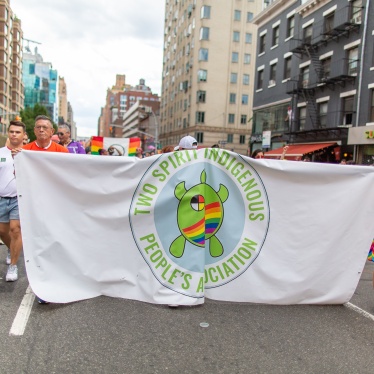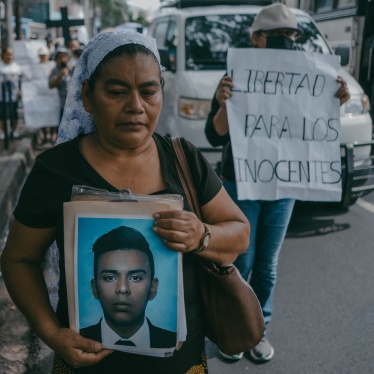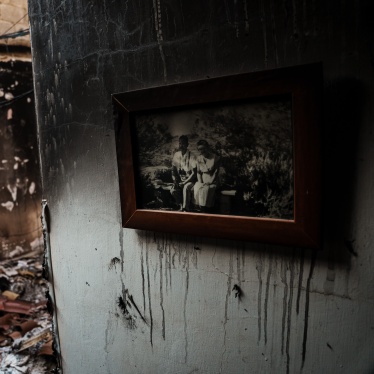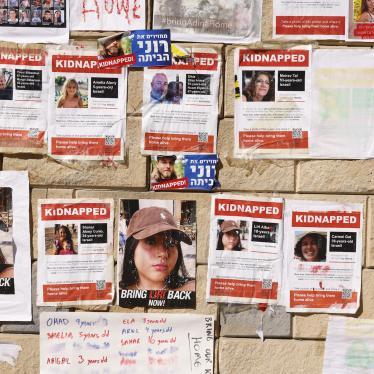Human Rights Watch welcomes the opportunity to provide input to the World Health Organization (WHO) High-level Working Group on Health and Human Rights of Women, Children and Adolescents. Human Rights Watch has produced a substantial body of research that describes the nexus between human rights violations and health outcomes in different contexts around the globe. The facts and recommendations below—drafted in response to the questions put out by the High-level Working Group—are based on our research findings.
- Where are we now? What progress has been made?
In the past decade, significant progress has been made in some areas of health rights affecting women, children, and adolescents. Most and perhaps all key international actors now clearly recognize that human rights abuses often have a diverse range of direct impacts on health. For example, there is increased political mobilization to end child marriage—which negatively affects health rights—through the Sustainable Development Goals, the Human Rights Council, the African Union, and national campaigns. There has also been significant progress in addressing stigma and discrimination as barriers to HIV prevention, testing, and treatment, and toward securing health rights of lesbian, gay, bisexual, and transgender (LGBT) people.
- Gaps and challenges in implementation of rights-based approaches
Protection from physical harm
Millions of women, children, and adolescents are exposed to toxic chemicals; suffer forced relocation for business interests with adverse health impacts; and an estimated 85 million children are engaged in hazardous child labor.[1] Women and girls around the world experience gender-based and sexual violence, child marriage, and female genital mutilation (FGM).[2]
In some contexts health professionals have themselves been involved in abuse against patients. For example, in South Africa our research documented that women in labor have reported pinching, slapping, and rough handling, treatment delays, and refusal of care.[3] In some countries health workers have also committed abuses under the guise of so-called treatment. For example, women, children, and adolescents with disabilities are often confined to institutions in the name of care and treatment. But inside facilities in many countries around the world, they face serious violence and abuse including shackling, involuntary and inappropriate medical treatment, seclusion and sedation, and other violations.[4] In many countries women and girls with disabilities have been subject to forced sterilization or forced to use contraceptives.[5] Health care workers in some countries perform abusive procedures such as female genital mutilation or “virginity testing.”[6] Elsewhere, transgender people have been forced to undergo invasive medical interventions such as surgery or forced sterilization as a requirement for official gender recognition. Anal exams are still used to “prove” homosexual conduct in medical settings in several countries, and gay adolescents have been coerced into undergoing therapies intended to “cure” homosexuality—both practices violate human rights and lack medical efficacy.[7]
The health rights of women, children, and adolescents can only be realized if they are protected by law against abuse, if preventive measures such as awareness-raising and training are in place, if laws are adequately monitored and enforced, and violations are appropriately investigated and prosecuted. Survivors of abuse need good quality physical and mental health care; yet in practice, they often face difficulty accessing health services and support.
Access to health care
Health policies tend to be focused narrowly on the provision of services, often through specific quantitative targets. However, these policies frequently fail to address broader human rights conditions which may prevent women, children, and adolescents from accessing health care and that can affect the quality of health care.
Stigma and discrimination against marginalized groups
Marginalized groups—including migrants and refugees, racial and ethnic minorities, the poor, indigenous peoples, LGBT people, orphaned children, and people with disabilities—are at risk of exclusion and frequently face significant barriers to health care. Women, children, and adolescents belonging to these groups are often particularly affected. Such groups often experience additional administrative hurdles, physical barriers, and discrimination in health services. Drugs users, sex workers, lesbian, gay, and transgender people face stigma and discrimination when accessing health services.[8] Our research has documented how in Kenya, children in need of HIV treatment have died because their guardians neglected them or were extremely poor and unable to reach health centers.[9]
Lack of availability of quality health services
In many parts of the world, health services are simply unavailable or so inadequate that they cannot provide the care needed. For example, primary care services for maternal health, emergency contraception, or post-exposure prophylaxis, are often not easily accessible. Lack of emergency obstetric care is a major cause of maternal and infant mortality.[10] For many people palliative care is altogether unavailable locally, forcing people who are very ill to travel long distances to access treatment for pain and other symptoms—or to suffer without it.[11] Adequate, appropriate, community-based and rights-respecting mental health care is lacking in many parts of the world.[12] Access to abortion services or to the interruption of pregnancy, which are safe and often necessary medical interventions for women and girls, are illegal or highly restricted in many countries.
Transport to far-flung health services in large cities is often particularly difficult for women, children, and adolescents. Many women and adolescent girls are in charge of childcare and other duties in the home and cannot leave. Children require an adult to go with them, making the trip to health facilities more costly and difficult. In some countries, legal and social norms require women to get a male guardian’s permission for travel or for health care.[13] Older women and women with disabilities often face physical difficulties making these trips.
Attacks on health facilities
Access to health care—including primary care services—is particularly challenging in conflict situations. Violence and threats against health workers and facilities, along with interference with access to health care, impedes the ability of millions of people around the world to receive the health services they need. Targeted attacks on health tend to have a disproportionate effect on women and children. They prevent women from getting maternal health care, including emergency obstetric care, and they prevent children from getting essential primary care in the first five critical years of their lives, including vaccinations and other essential care.[14]
Failure to gear health services to the needs of women, children, and adolescents
Health services are not always geared towards the specific medical and social needs of women, children, and adolescents. For example, children in need of palliative care require different types of treatment and support, including other types of medication, child-friendly formulations, and child-centered psychosocial support.[15] Adolescents often avoid generalized access HIV services in their community, where they may face stigma, and are more likely to go to adolescent health clinics where they can meet peers with similar issues.[16]
Access to health information
Many people lack access to information about health risks and health issues affecting them. For example, people in many countries lack basic information related to the quality of their drinking water, and the health impacts of water contaminants.[17] In multiple research projects, we have found that governments and companies have failed to inform communities about environmental health risks related, for example, to mining and other business activity.[18] Human Rights Watch has also documented how women, children, and adolescents with disabilities have been denied health information and forced to take medication without their informed consent.[19]
In many parts of the world, women, children, and adolescents are denied access to comprehensive sexual and reproductive health information, in part due to social norms around sexuality and morality. Women, children, and adolescents are also often denied accurate information on related issues such as FGM and sexually transmitted diseases, including HIV. Stigma or shame may prevent them from seeking medical care after sexual violence.[20] In many countries, sexual education programs do not inform about homosexuality, and the distribution of information about “non-traditional” sexual relations to adolescents is sometimes banned.[21]
As a result of poor access to sexual and reproductive health information, millions of women, children, and adolescents around the world do not know how to prevent pregnancy or safely terminate unwanted pregnancies; do not know they have sexually transmitted diseases, including HIV; lack information about their right to refuse sex and other rights relating to sexuality; and are unable to negotiate safer sex. Girls who get pregnant—often because they lack sex education—are at higher risk of experiencing birth complication and maternal death than adult women; they also commonly drop out of school when they have a baby. For adult women, lack of information, mobility, and resources negatively affect their access to and use of reproductive health information. Lack of health information may cause women, children, and adolescents to suffer needlessly, engage in risky behavior, stop taking medication, or feel betrayed and stigmatized. For LGBT adolescents, fact- and rights-based information about LGBT lives is vital to a healthy sense of self, access to health services, and promotion of understanding amongst peers.[22]
Weak linkages between health, police, and protective services
Weak and discriminatory response to victims of violence by law enforcement can result in continued violence and significant delays in treatment and care. For example, when police do not respond appropriately to reports of domestic violence, victims are often returned to abusive environments and the risk of further harm.[23] When law enforcement fails to enforce the age of marriage, high prevalence of child marriage continues along with its associated health risks.
In addition, victims of sexual violence face significant barriers to reporting both in health care settings and to law enforcement. Human Rights Watch has documented how health professionals in some countries have blamed victims for their behavior, engaged in abusive and discredited practices such as virginity testing against victims of sexual abuse, or turned victims away from accessing the services they need. Laws requiring victims of sexual violence to go through non-health related procedures, for example to get a virginity test or to file a criminal complaint to access legal abortion, can also make victims less likely to seek help from healthcare providers.[24] LGBT survivors of sexual violence often fear further abuses if they disclose either their identity or the abuse to health care providers or police, particularly in countries where same-sex conduct is criminalized.[25]
Lack of participation of women, children, and adolescents in health policy
Women, children, and adolescents and civil society groups representing them are often not involved in health policy making at international, national, or subnational levels. In some cases, civil society groups or affected populations are harassed and attacked when they do seek to speak out.[26]
- Monitoring and accountability for health and human rights
Individuals need accessible and easily comprehensible ways to file complaints about mistreatment suffered while accessing health services, and effective grievance redress. This contributes to accountability for those responsible and collecting information to deter future abuse. Effective complaints mechanisms should highlight discrimination, failures in supervision of health workers, failure to adhere to standard protocols, and breaches in ethical practice.
Overall monitoring and data collection on health and human rights is often missing. This makes it harder to know when health rights are violated, what the scale of the problem is, and what should be done about it. An example is the dearth of information on children’s exposure to many toxic pollutants, such as heavy metals or air pollution; the lack of detailed data for specific geographic regions makes it difficult to push for action.[27]
Careful monitoring may allow for corrective action to improve the accessibility and quality of health care and health outcomes. For example, maternal death audits can help identify changes to policy and practice to prevent further maternal deaths.[28] But accountability has to go beyond corrective action. When health officials or other individuals commit health-related abuses, their actions should be investigated and, if there is sufficient evidence of a crime or other actionable transgression, they should be held accountable. A case in point is the prosecution of those responsible for attacks on health facilities in armed conflict.
In addition, governments have often failed to regulate and hold accountable companies that contribute to health rights violations.[29] Human Rights Watch has documented the effects of pollution from leather tanneries, small-scale and large-scale mining, battery smelters, and agro-industry. Governments should hold businesses accountable for health rights abuses they contribute to, and monitor or regulate the extraterritorial conduct of companies domiciled in within their jurisdictions.
It is crucial that governments conduct more systematic monitoring of human rights abuses linked to the health rights of women, children, and adolescents, including through reports to national human rights bodies and international human rights mechanisms such as the Universal Periodic Review and treaty bodies. Governments should also develop measures to ensure accountability for such incidents. Civil society groups should be formally involved in the design, monitoring, and evaluation of health strategies. Governments should facilitate dialogue and engagement between local, regional, and national health actors and human rights groups.
[1] Human Rights Watch, “Child Rights and the Environment – The Need For Action: Submission by Human Rights Watch to the Committee on the Rights of the Child,” July 22, 2016, https://www.hrw.org/news/2016/07/22/child-rights-and-environment-need-action; Human Rights Watch, “What is a House without Food?” Mozambique’s Coal Mining Boom and Resettlements, May 2013, https://www.hrw.org/report/2013/05/23/what-house-without-food/mozambiques-coal-mining-boom-and-resettlements;“What … if Something Went Wrong?” Hazardous Child Labor in Small-Scale Gold Mining in the Philippines, September 2015, https://www.hrw.org/report/2015/09/29/what-if-something-went-wrong/hazardous-child-labor-small-scale-gold-mining.
[2] Human Rights Watch, They Took Me and Told Me Nothing” Female Genital Mutilation in Iraqi Kurdistan, June 2010, https://www.hrw.org/report/2010/06/16/they-took-me-and-told-me-nothing/female-genital-mutilation-iraqi-kurdistan; No Way Out: Child Marriage and Human Rights Abuses in Tanzania, October 2014, https://www.hrw.org/report/2014/10/29/no-way-out/child-marriage-and-human-rights-abuses-tanzania; “I Just Sit and Wait to Die” Reparations for Survivors of Kenya’s 2007-2008 Post-Election Sexual Violence, February 2016, https://www.hrw.org/report/2016/02/15/i-just-sit-and-wait-die/reparations-survivors-kenyas-2007-2008-post-election; “Our Time to Sing and Play” Child Marriage in Nepal, September 2016,
https://www.hrw.org/report/2016/09/07/our-time-sing-and-play/child-marriage-nepal.
[3] Human Rights Watch, “Stop Making Excuses” Accountability for Maternal Health Care in South Africa, August 2011, https://www.hrw.org/report/2011/08/08/stop-making-excuses/accountability-maternal-health-care-south-africa.
[4] Human Rights Watch, Abandoned by the State: Violence, Neglect, and Isolation for Children with Disabilities in Russian Orphanages, September 2014, https://www.hrw.org/report/2014/09/15/abandoned-state/violence-neglect-and-isolation-children-disabilities-russian; “Treated Worse than Animals” Abuses against Women and Girls with Psychosocial or Intellectual Disabilities in Institutions in India, December 2014, https://www.hrw.org/report/2014/12/03/treated-worse-animals/abuses-against-women-and-girls-psychosocial-or-intellectual; “It is My Dream to Leave This Place” Children with Disabilities in Serbian Institutions, June 2016, https://www.hrw.org/news/2016/06/08/serbia-children-disabilities-neglected.
[5] Human Rights Watch, “Treated Worse than Animals;” “Sterilization of Women and Girls with Disabilities, Human Rights Watch briefing paper, November 10, 2011, https://www.hrw.org/news/2011/11/10/sterilization-women-and-girls-disabilities; United Nations Committee on the Rights of Persons with Disabilities (CRPD), Concluding observations on the initial report of Mauritius, CRPD/C/MUS/CO/1, 30 September 2015, https://documents-dds-ny.un.org/doc/UNDOC/GEN/G15/222/66/PDF/G1522266.pdf?OpenElement (accessed November 3, 2016), para. 29; UN CRPD, Implementation of the Convention on the Rights of Persons with Disabilities Initial reports submitted by States parties under article 35 of the Convention: New Zealand, CRPD/C/NZL/1, 31 March 2011, http://tbinternet.ohchr.org/_layouts/treatybodyexternal/Download.aspx?symbolno=CRPD%2FC%2FNZL%2F1&Lang=en (accessed Novembers 3, 2016), para. 37.
[6] “UN: WHO Condemns ‘Virginity Tests’,” Human Rights Watch news release, December 1, 2014, https://www.hrw.org/news/2014/12/01/un-who-condemns-virginity-tests; Human Rights Watch, Dignity on Trial, India’s Need for Sound Standards for Conducting and Interpreting Forensic Examinations of Rape Survivors, September 6, 2010, https://www.hrw.org/report/2010/09/06/dignity-trial/indias-need-sound-standards-conducting-and-interpreting-forensic.
[7] Human Rights Watch Submission to the Committee on the Rights of the Child, April 2, 2015, https://www.hrw.org/news/2015/04/02/human-rights-watch-submission-committee-rights-child; Human Rights Watch, Dignity Debased: Forced Anal Examinations in Homosexuality Prosecutions, July 2016, https://www.hrw.org/report/2016/07/12/dignity-debased/forced-anal-examinations-homosexuality-prosecutions.
[8] Human Rights Watch, We'll Show You You're a Woman" Violence and Discrimination against Black Lesbians and Transgender Men in South Africa, December 2011, https://www.hrw.org/report/2011/12/05/well-show-you-youre-woman/violence-and-discrimination-against-black-lesbians-and; “Treat Us Like Human Beings” Discrimination against Sex Workers, Sexual and Gender Minorities, and People Who Use Drugs in Tanzania, June 2013, https://www.hrw.org/report/2013/06/18/treat-us-human-beings/discrimination-against-sex-workers-sexual-and-gender.
[9] Human Rights Watch, A Question of Life or Death: Treatment Access for Children Living With HIV in Kenya, December 2008, https://www.hrw.org/report/2008/12/16/question-life-or-death/treatment-access-children-living-hiv-kenya
[10] Human Rights Watch, No Tally of the Anguish, Accountability in Maternal Health Care in India, October 2009, https://www.hrw.org/report/2009/10/07/no-tally-anguish/accountability-maternal-health-care-india; “Stop Making Excuses” Accountability for Maternal Health Care in South Africa, August 2011, https://www.hrw.org/report/2011/08/08/stop-making-excuses/accountability-maternal-health-care-south-africa.
[11] Human Rights Watch, Abandoned in Agony: Cancer and the Struggle for Pain Treatment in Senegal, October 2013, https://www.hrw.org/report/2013/10/24/abandoned-agony/cancer-and-struggle-pain-treatment-senegal; Care When There Is No Cure Ensuring the Right to Palliative Care in Mexico, October 2014, https://www.hrw.org/report/2014/10/28/care-when-there-no-cure/ensuring-right-palliative-care-mexico; “All I Can Do Is Cry” Cancer and the Struggle for Palliative Care in Armenia, July 2015, https://www.hrw.org/report/2015/07/14/all-i-can-do-cry/cancer-and-struggle-palliative-care-armenia; “Pain Tears Me Apart” Challenges and Progress in Ensuring the Right to Palliative Care in Morocco, February 2016, https://www.hrw.org/report/2016/02/04/pain-tears-me-apart/challenges-and-progress-ensuring-right-palliative-care-morocco.
[12] Human Rights Watch Submission to the United Nations Committee on the Rights of Persons with Disabilities regarding Croatia, August 30, 2014, https://www.hrw.org/news/2014/08/30/human-rights-watch-submission-united-nations-committee-rights-persons-disabilities; “Iraq: ISIS Escapees Describe Systematic Rape, Yezidi Survivors in Need of Urgent Care,” Human Rights Watch news release, April 14, 2015, https://www.hrw.org/news/2015/04/14/iraq-isis-escapees-describe-systematic-rape; Human Rights Watch, Living in Hell: Abuses against People with Psychosocial Disabilities in Indonesia, March 2016, https://www.hrw.org/report/2016/03/21/living-hell/abuses-against-people-psychosocial-disabilities-indonesia.
[13] Human Rights Watch, Boxed In, Women and Saudi Arabia’s Male Guardianship System, July 2016, https://www.hrw.org/report/2016/07/16/boxed/women-and-saudi-arabias-male-guardianship-system.
[14] Human Rights Watch, Attacks on Health, Global Report, May 2015,
https://www.hrw.org/sites/default/files/related_material/HHR%20Attacks%20on%20Hospitals%20brochure%200515%20LOWRES.pdf.
[15] Human Rights Watch, Needless Pain, Government Failure to Provide Palliative Care for Children in Kenya, September 2010, https://www.hrw.org/report/2010/09/09/needless-pain/government-failure-provide-palliative-care-children-kenya.
[16] Human Rights Watch, A Question of Life or Death.
[17] Human Rights Watch, Toxic Water, Tainted Justice: Thailand’s Delays in Cleaning Up Klity Creek, December 2014, https://www.hrw.org/report/2014/12/16/toxic-water-tainted-justice/thailands-delays-cleaning-klity-creek; Nepotism and Neglect, The Failing Response to Arsenic in the Drinking Water of Bangladesh’s Rural Poor, April 2016, https://www.hrw.org/report/2016/04/06/nepotism-and-neglect/failing-response-arsenic-drinking-water-bangladeshs-rural; “Canada: Water Crisis Puts First Nations Families at Risk, Regulation, Investment, and Oversight Needed to Fix Broken System,” Human Rights Watch news release, June 07, 2016, https://www.hrw.org/news/2016/06/07/canada-water-crisis-puts-first-nations-families-risk.
[18] Human Rights watch, “They Destroyed Everything” Mining and Human Rights in Malawi, September 2016, https://www.hrw.org/report/2016/09/27/they-destroyed-everything/mining-and-human-rights-malawi.
[19] Human Rights Watch, Treated Worse Than Animals, p. 9. Living in Hell, p. 47; It is My Dream to Leave This Place.
[20] Human Rights Watch, “Nobody Remembers Us” Failure to Protect Women’s and Girls’ Right to Health and Security in Post-Earthquake Haiti, August 2011, https://www.hrw.org/report/2011/08/19/nobody-remembers-us/failure-protect-womens-and-girls-right-health-and-security.
[21] Human Rights Watch, License to Harm: Violence and Harassment against LGBT People and Activists in Russia, December 2014, https://www.hrw.org/report/2014/12/15/license-harm/violence-and-harassment-against-lgbt-people-and-activists-russia; Human Rights Watch Letter to the Government of South Korea on Human Rights and Comprehensive Sexuality Education, July 21, 2016, https://www.hrw.org/news/2015/07/21/letter-government-south-korea-human-rights-and-comprehensive-sexuality-education.
[22] Kanae Doi, “Japan’s Chance at an LGBT-Inclusive Curriculum: School Guidelines Should Address Sexual Orientation, Gender Identity,” October 12, 2016, https://www.hrw.org/news/2016/10/12/japans-chance-lgbt-inclusive-curriculum.
[23] “Kyrgyzstan: End Barriers to Help for Domestic Violence Victims, Gaps in Government Response Put Women’s Lives at Risk, Human Rights Watch news release, October 28, 2015, https://www.hrw.org/news/2015/10/28/kyrgyzstan-end-barriers-help-domestic-violence-victims.
[24] Rothna Begum, “‘Virginity Testing’ to End for Yezidi Rape Survivors”, January 27, 2016, https://www.hrw.org/news/2016/01/27/dispatches-virginity-testing-end-yezidi-rape-survivors
[25] Human Rights Watch, “That’s When I Realized I Was Nobody” A Climate of Fear for LGBT People in Kazakhstan, July 2015, https://www.hrw.org/report/2015/07/23/thats-when-i-realized-i-was-nobody/climate-fear-lgbt-people-kazakhstan; “All Five Fingers Are Not the Same” Discrimination on Grounds of Gender Identity and Sexual Orientation in Sri Lanka, August 2016, https://www.hrw.org/report/2016/08/14/all-five-fingers-are-not-same/discrimination-grounds-gender-identity-and-sexual.
[26] Katharina Rall, “Dispatches: Standing Up for Environmental Activists,” April 22, 2015, https://www.hrw.org/news/2015/04/22/dispatches-standing-environmental-activists.
[27] Report of the Special Rapporteur on the implications for human rights of the environmentally sound management and
disposal of hazardous substances and wastes to the United Nations General Assembly, A/HRC/33/41, 2 August 2016, http://www.srtoxics.org/wp-content/uploads/2016/09/Rights-of-Child-and-Toxics.pdf (accessed November 3, 2016).
[28] Human Rights Watch, No Tally of the Anguish.
[29] Human Rights Watch, “Child Rights and the Environment – The Need For Action: Submission by Human Rights Watch to the Committee on the Rights of the Child.”





